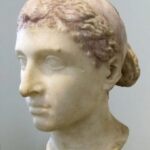Is there any document or work whose author was Cleopatra VII preserved to our times? According to later Arab sources, the last queen of Egypt, apart from her beauty, was also distinguished by intelligence and broad knowledge. She was reportedly the author of works on medicine, pharmacy, toxicology and cosmetology. Naturally, however, none of the works has survived to our times. However, we have another very interesting archaeological material.
At the beginning of the 20th century, mummies with papyri placed on their bodies were discovered in the ancient cemetery of Abusir el-Melek (northern Egypt). As it turned out, two of them were fragments of a royal decree, which is dated February 23, 33 BCE. Currently, the artifact is in Berlin at the Staatliche Museen zu Berlin.
What can we read from the document? The decree informs that a certain Publius Canidius Crassus – the commander and trusted man of Mark Antony – received a perpetual (also passed on to his children) exemption from the tax on wheat exports and imports of wine and other products. According to the document, a Roman can transport up to 300 tons of wheat annually, and bring 5,000 amphoras.
In addition, the man does not have to pay taxes for his arable land in Egypt, people, animals or merchant ships, and is exempt from paying tax officials arriving for inspections. The decree is a great example of how tax law worked and how connections allowed people to avoid paying tributes or taxes.
What is most interesting, however, at the end of the document there is an inscription in Greek: “Make it happen” (Greek γινέσθωι, ginesthō), which was probably a form of a signature or a paraphrase for the execution of the decree. It is clearly different from the rest of the content, and therefore another person had to execute it. Given the place, year, and the fact that Cleopatra was ruling in Egypt at that time, with the support of her beloved Antony, who spoke Greek every day, it seems that it could be her handwriting. On the other hand, it could also be her secretary carrying out her orders.







